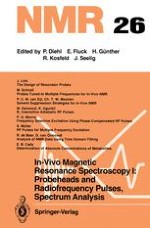1992 | OriginalPaper | Buchkapitel
Solvent Suppression Strategies for In Vivo Magnetic Resonance Spectroscopy
verfasst von : Peter C. M. van Zijl, Chrit T. W. Moonen
Erschienen in: In-Vivo Magnetic Resonance Spectroscopy I: Probeheads and Radiofrequency Pulses Spectrum Analysis
Verlag: Springer Berlin Heidelberg
Enthalten in: Professional Book Archive
Aktivieren Sie unsere intelligente Suche, um passende Fachinhalte oder Patente zu finden.
Wählen Sie Textabschnitte aus um mit Künstlicher Intelligenz passenden Patente zu finden. powered by
Markieren Sie Textabschnitte, um KI-gestützt weitere passende Inhalte zu finden. powered by
Despite its obvious potential for assessing in vivo metabolism, NMR spectroscopy has yet to acquite a significant place in clinical practice. This situation can be partly ascribed to the technique’s inherently low sensitivity and to the low metabolite concentrations. Thus, compared to the microliter resolution of clinical MRI, metabolite spectroscopy suffers from low spatial resolution. When acquiring larger volumes (1–100 ml) to attain sufficient signal, specificity may be lost due to tissue heterogeneity. This greatly complicates the reproducibility of clinical trials, especially in cases where the size (or position) of the lesion changes. For the purposes of sensitivity and access to many metabolites, it is advantageous to use proton NMR. However, proton spectroscopy is hampered by its limited spectral resolution and by the need to effectively suppress the dominating water and lipid resonances. The strategies that can be employed to attain suppression of these and other unwanted resonances are the topic of this review.
